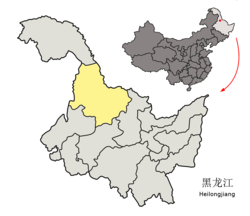Nenjiang City (Chinese: 嫩江市; pinyin: Nènjiāng shì), formerly Nenjiang County, is a county-level city under the administration of Heihe prefecture-level city in northwestern Heilongjiang province, China. It is located on the river of the same name (Nen River), which also forms part of the provincial border with Inner Mongolia, more than 200 kilometres (120 mi) southwest of the urban area of Heihe. The city seat is Nenjiang Town. Land area 15,360 square kilometres (5,930 sq mi), population 500,000.
Nenjiang
嫩江市 Mergen; Nunkiang | |
|---|---|
 Nenjiang in Heihe | |
 Heihe in Heilongjiang | |
| Coordinates: 49°07′N 125°08′E / 49.11°N 125.13°E | |
| Country | People's Republic of China |
| Province | Heilongjiang |
| Prefecture-level city | Heihe |
| City seat | Nenjiang Town |
| Area | |
• Total | 15,360 km2 (5,930 sq mi) |
| Elevation | 230 m (750 ft) |
| Population | |
• Total | 500,000 |
| • Density | 33/km2 (84/sq mi) |
| Time zone | UTC+8 (China Standard) |
| Postal code | 161400 |
| Area code | 0456 |
| Website | www |
History
editUnder the name Mergen or Merghen (墨爾根, Mò'ěrgēn), Nenjiang was the provincial capital and seat of the military governor of Heilongjiang Province in 1690–1699.[1]
Geography and climate
editNenjiang has a monsoon-influenced humid continental climate (Köppen Dwb), with long, harsh, but dry winters, and short, very warm summers. The monthly 24-hour average temperature ranges from −23.3 °C (−9.9 °F) in January to 21.1 °C (70.0 °F) in July; the year averages out at only 0.85 °C (33.5 °F). Around 80% of the annual precipitation occurs from June to September. With monthly percent possible sunshine ranging from 53% in July to 74% in February, sunshine is generous year-round, totalling 2,726 hours annually.
| Climate data for Nenjiang (1991–2020 normals, extremes 1971–2010) | |||||||||||||
|---|---|---|---|---|---|---|---|---|---|---|---|---|---|
| Month | Jan | Feb | Mar | Apr | May | Jun | Jul | Aug | Sep | Oct | Nov | Dec | Year |
| Record high °C (°F) | 0.4 (32.7) |
6.4 (43.5) |
19.7 (67.5) |
28.6 (83.5) |
37.0 (98.6) |
40.0 (104.0) |
37.7 (99.9) |
34.4 (93.9) |
33.9 (93.0) |
26.8 (80.2) |
12.6 (54.7) |
1.8 (35.2) |
40.0 (104.0) |
| Mean daily maximum °C (°F) | −16.4 (2.5) |
−10.4 (13.3) |
−0.5 (31.1) |
11.4 (52.5) |
20.1 (68.2) |
25.7 (78.3) |
27.2 (81.0) |
24.9 (76.8) |
19.3 (66.7) |
9.3 (48.7) |
−4.6 (23.7) |
−15.1 (4.8) |
7.6 (45.6) |
| Daily mean °C (°F) | −23.0 (−9.4) |
−18.1 (−0.6) |
−7.3 (18.9) |
4.8 (40.6) |
13.3 (55.9) |
19.4 (66.9) |
21.7 (71.1) |
19.1 (66.4) |
12.6 (54.7) |
3.2 (37.8) |
−10.3 (13.5) |
−20.9 (−5.6) |
1.2 (34.2) |
| Mean daily minimum °C (°F) | −29 (−20) |
−25.3 (−13.5) |
−14.4 (6.1) |
−2.3 (27.9) |
5.9 (42.6) |
12.9 (55.2) |
16.3 (61.3) |
13.7 (56.7) |
6.3 (43.3) |
−2.6 (27.3) |
−15.9 (3.4) |
−26.4 (−15.5) |
−5.1 (22.9) |
| Record low °C (°F) | −43.9 (−47.0) |
−42.1 (−43.8) |
−37.2 (−35.0) |
−17.9 (−0.2) |
−8.6 (16.5) |
0.0 (32.0) |
5.8 (42.4) |
2.1 (35.8) |
−7.0 (19.4) |
−25.5 (−13.9) |
−35.4 (−31.7) |
−42.2 (−44.0) |
−43.9 (−47.0) |
| Average precipitation mm (inches) | 3.7 (0.15) |
3.5 (0.14) |
5.1 (0.20) |
16.7 (0.66) |
44.2 (1.74) |
87.8 (3.46) |
123.9 (4.88) |
111.4 (4.39) |
60.0 (2.36) |
23.5 (0.93) |
7.9 (0.31) |
5.6 (0.22) |
493.3 (19.44) |
| Average precipitation days (≥ 0.1 mm) | 5.9 | 3.7 | 4.3 | 6.0 | 9.4 | 12.7 | 14.0 | 13.1 | 9.3 | 6.4 | 5.9 | 6.7 | 97.4 |
| Average snowy days | 8.5 | 6.4 | 6.4 | 3.9 | 0.3 | 0 | 0 | 0 | 0.1 | 3.6 | 8.1 | 9.5 | 46.8 |
| Average relative humidity (%) | 70 | 67 | 59 | 48 | 49 | 63 | 76 | 79 | 69 | 60 | 67 | 71 | 65 |
| Mean monthly sunshine hours | 175.1 | 208.0 | 253.8 | 245.0 | 267.6 | 260.0 | 244.3 | 240.8 | 227.7 | 203.6 | 169.7 | 152.2 | 2,647.8 |
| Percent possible sunshine | 65 | 72 | 68 | 59 | 56 | 54 | 51 | 55 | 61 | 62 | 63 | 60 | 61 |
| Source 1: China Meteorological Administration[2][3] | |||||||||||||
| Source 2: Weather China[4] | |||||||||||||
Administrative divisions
editNenjiang City is divided into 9 towns and 5 townships.[5]
- 9 towns
- Nenjiang (嫩江镇), Yilaha (伊拉哈镇), Shuangshan (双山镇), Duobaoshan (多宝山镇), Haijiang (海江镇), Qianjin (前进镇), Zhangfu (长福镇), Keluo (科洛镇), Huolongmen (霍龙门镇)
- 5 townships
- Linjiang (临江乡), Lianxing (联兴乡), Baiyun (白云乡), Taxi (塔溪乡), Changjiang (长江乡)
References
edit- ^ Edmonds, Richard Louis (1985). Northern Frontiers of Qing China and Tokugawa Japan: A Comparative Study of Frontier Policy. University of Chicago, Department of Geography; Research Paper No. 213. pp. 115–117. ISBN 0-89065-118-3.
- ^ 中国气象数据网 – WeatherBk Data (in Simplified Chinese). China Meteorological Administration. Retrieved 5 July 2023.
- ^ 中国气象数据网 (in Simplified Chinese). China Meteorological Administration. Retrieved 5 July 2023.
- ^ 嫩江 - 气象数据 -中国天气网 (in Chinese). Weather China. Retrieved 28 November 2022.
- ^ "国家统计局" (in Chinese). National Bureau of Statistics of the People's Republic of China. Retrieved 2021-12-07.